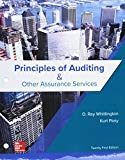
GEN COMBO LL PRINCIPLES OF AUDITING & OTHER ASSURANCE SERVICES; CONNECT AC
21st Edition
ISBN: 9781260427202
Author: Ray Whittington, Kurt Pany
Publisher: McGraw-Hill Education
expand_more
expand_more
format_list_bulleted
Question
Chapter 7, Problem 27QRA
a.
To determine
Explain the remaining stages of the auditor’s consideration.
b.
To determine
Provide an example of the audit procedure for each stage.
Expert Solution & Answer
Want to see the full answer?
Check out a sample textbook solution
Students have asked these similar questions
Hindenburger, Inc., began operations on January 1. It made 5,000
burgers and sold 4,000 of them. Hindenburger incurred the following
costs:
Raw materials
$1,000
Wagos of production workers
7,000
Rent for corporate headquarters
5,000
Depreciation on manufacturing equipment
2,000
Commissions paid to sales people
4,000
Calculate the total product cost for the year ended December 31.
Horizon Innovations incurred $120,000 in research
and development costs and $60,000 in legal fees to
acquire a patent. The patent has a legal life of 20
years and a useful life of 8 years.
What amount should Horizon record as Patent
Amortization Expense in the first year?
a. $7,500
b. $15.000
c. $22,500
d. $0
Drake Goods reports net income of $310,000, sales of $9,200,000, and average assets of $860,000. What is the profit margin?
Chapter 7 Solutions
GEN COMBO LL PRINCIPLES OF AUDITING & OTHER ASSURANCE SERVICES; CONNECT AC
Ch. 7 - Prob. 1RQCh. 7 - Prob. 2RQCh. 7 - Prob. 3RQCh. 7 - Prob. 4RQCh. 7 - Prob. 5RQCh. 7 - Prob. 6RQCh. 7 - Prob. 7RQCh. 7 - Identify the four types of control activities and...Ch. 7 - One basic concept of internal control is that no...Ch. 7 - Prob. 10RQ
Ch. 7 - Prob. 11RQCh. 7 - Prob. 12RQCh. 7 - Prob. 13RQCh. 7 - Prob. 14RQCh. 7 - Prob. 15RQCh. 7 - Prob. 16RQCh. 7 - Prob. 17RQCh. 7 - Prob. 18RQCh. 7 - Prob. 19RQCh. 7 - Prob. 20RQCh. 7 - Prob. 21RQCh. 7 - Prob. 22RQCh. 7 - Prob. 23RQCh. 7 - Management is responsible for designing and...Ch. 7 - Prob. 25QRACh. 7 - Prob. 26QRACh. 7 - Prob. 27QRACh. 7 - Prob. 28QRACh. 7 - Prob. 29QRACh. 7 - Prob. 30QRACh. 7 - Prob. 31QRACh. 7 - During your first audit of a medium-size...Ch. 7 - Prob. 33QRACh. 7 - Prob. 34QRACh. 7 - Which of the following would be least likely to be...Ch. 7 - Prob. 35BOQCh. 7 - Prob. 35COQCh. 7 - Prob. 35DOQCh. 7 - Prob. 35EOQCh. 7 - Prob. 35FOQCh. 7 - Prob. 35GOQCh. 7 - Prob. 35HOQCh. 7 - Which of the following is not an advantage of...Ch. 7 - Prob. 35JOQCh. 7 - Prob. 35KOQCh. 7 - Prob. 35LOQCh. 7 - Prob. 36OQCh. 7 - Listed below are controls that have been developed...Ch. 7 - Prob. 38OQCh. 7 - For each term in the first column, find the...Ch. 7 - Prob. 40AOQCh. 7 - Prob. 40BOQCh. 7 - Prob. 40COQCh. 7 - Prob. 40DOQCh. 7 - Prob. 40EOQCh. 7 - Prob. 41PCh. 7 - Prob. 42PCh. 7 - Prob. 43PCh. 7 - Prob. 44PCh. 7 - Prob. 45ITC
Knowledge Booster
Similar questions
- Answerarrow_forward??arrow_forwardSolomon Manufacturing Company began operations on January 1. During the year, it started and completed 1,790 units of product. The financial statements are prepared in accordance with GAAP. The company incurred the following costs: 1 Raw materials purchased and used 2 Wages of production workers $ 3,060 $ 3,590 3 Salaries of administrative and sales personnel $ 1,915 $ 6,417 $1,760 4 Depreciation on manufacturing equipment 5 Depreciation on administrative equipment Solomon sold 1,030 units of product. Required: a. Determine the total product cost for the year. b. Determine the total cost of the ending inventory. c. Determine the total cost of goods sold.arrow_forward
- A business had: • Assets on Dec 31, Year 1: $820,000 • Liabilities on Dec 31, Year 1: $310,000 • Owner investments in Year 2: $45,000 Dividends paid in Year 2: $25,000 • Assets on Dec 31, Year 2: $870,000 • Liabilities on Dec 31, Year 2: $290,000 What is net income for Year 2?arrow_forwardWHICH OF THE FOLLOWING IS AN EXAMPLE OF A LABOR COST STANDARD? A. $40 PER DIRECT LABOR HOUR B. 50 SQUARE FEET PER UNIT C. $0.95 PER SQUARE FOOT D. 0.5 DIRECT LABOR HOURS PER UNITarrow_forwardAlpine Tech Corporation has a marginal tax rate of 40% and an average tax rate of 25%. If the company earns $120,000 in taxable income, how much will it owe in taxes? a. $30,000 b. $35,000 c. $40,000 d. $48,000arrow_forward
- What is the effective rate of interest if the loan is discounted ? accountingarrow_forwardWhat amount of indirect cost would be assigned if services to a project required $40,000 ofarrow_forwardPlease given correct answer for Financial accounting question I need step by step explanationarrow_forward
arrow_back_ios
SEE MORE QUESTIONS
arrow_forward_ios
Recommended textbooks for you
 Auditing: A Risk Based-Approach (MindTap Course L...AccountingISBN:9781337619455Author:Karla M Johnstone, Audrey A. Gramling, Larry E. RittenbergPublisher:Cengage Learning
Auditing: A Risk Based-Approach (MindTap Course L...AccountingISBN:9781337619455Author:Karla M Johnstone, Audrey A. Gramling, Larry E. RittenbergPublisher:Cengage Learning Auditing: A Risk Based-Approach to Conducting a Q...AccountingISBN:9781305080577Author:Karla M Johnstone, Audrey A. Gramling, Larry E. RittenbergPublisher:South-Western College Pub
Auditing: A Risk Based-Approach to Conducting a Q...AccountingISBN:9781305080577Author:Karla M Johnstone, Audrey A. Gramling, Larry E. RittenbergPublisher:South-Western College Pub

Auditing: A Risk Based-Approach (MindTap Course L...
Accounting
ISBN:9781337619455
Author:Karla M Johnstone, Audrey A. Gramling, Larry E. Rittenberg
Publisher:Cengage Learning

Auditing: A Risk Based-Approach to Conducting a Q...
Accounting
ISBN:9781305080577
Author:Karla M Johnstone, Audrey A. Gramling, Larry E. Rittenberg
Publisher:South-Western College Pub